Dog Is My Co-Pilot
Dr. Peter Rork
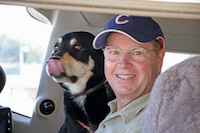 Orthopedic Surgeon Dr. Peter Rork quit his thriving practice to create "Dog Is My Co-Pilot," a non-profit organization dedicated to flying dogs and cats from kill-shelters to rescues that can re-home them. So far Dr. Rork has transported over 10,000 animals, much of it at his expense. He explains why this is more rewarding than orthopedic surgery.
Orthopedic Surgeon Dr. Peter Rork quit his thriving practice to create "Dog Is My Co-Pilot," a non-profit organization dedicated to flying dogs and cats from kill-shelters to rescues that can re-home them. So far Dr. Rork has transported over 10,000 animals, much of it at his expense. He explains why this is more rewarding than orthopedic surgery.
Dr. Peter Rork quit medicine about nine years ago after being in orthopedics for over 30 years. He tells us laws were changing and he was just getting a little fatigued. Then he had a tragedy in his life. His wife died suddenly of cardiac arrest and fell into a coma. He had her at home for about 10 days before she passed. He tells us that really broke him and he just couldn't go back to medicine after that.
After the death of his wife, Dr. Rork created Dog Is My Co-Pilot. He is currently flying a Cessna Caravan, but originally started with a six-seater Cessna Stationair with a piston engine. He was flying about a thousand animals a year with that, but quickly outgrew that plane. They transport from nonprofits to nonprofits. They only transport from a kill facility to a non-kill facility. There is never a charge for the organization that is sending the animals or a charge to the organizations that are receiving the animals. They rely strictly on public donations.
The facilities where they pick up animals are in West Texas, New Mexico, Arizona and the Central Valley of California. Some of these places have a kill rate of up to 80-percent. So the folks at these locations are desperate to move these animals out. They really have only three choices. They can either adopt them out, they can transport them, or they euthanize them, sadly. The facilities that are near them are usually in the same boat that they are, so it's not as if they can drive them two hours away and find a new home. They have to move them great distances. So they will usually load up a van and they'll drive 12 to 14 hours with dogs and cats in the back. As you can imagine, you don't let the dogs out to pee every three hours. Once they're in the crate, they are in the crate until they get to their destination. All of the facilities in the south are grateful for the work that Dog Is My Co-Pilot does in helping them transport the animals.
What Dog Is My Co-Pilot affords these facilities is that they can greatly expand the geographic area where these dogs can be moved. And it seems that the farther north you get, if you draw a line between Denver and Salt Lake City, the farther north you get, the more there is a need for dogs. They understand the spay and neuter laws and they enforce them. You don't see dogs running free in the street or in packs. Then the farther south you get from that line, the worse it is.
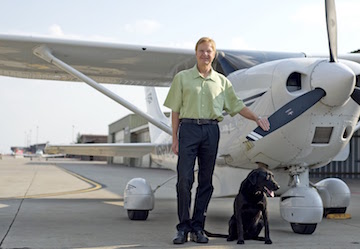 A flight for Dog Is My Co-Pilot usually lasts three to four days. For instance, Dr. Rork will fly down to Hobbs, New Mexico and spend the night. Then he will load up the aircraft with dogs from Hobbs and Roswell and he will fly them to Denver and Salt Lake City. Then he will scoot down to phoenix and spend the night.
A flight for Dog Is My Co-Pilot usually lasts three to four days. For instance, Dr. Rork will fly down to Hobbs, New Mexico and spend the night. Then he will load up the aircraft with dogs from Hobbs and Roswell and he will fly them to Denver and Salt Lake City. Then he will scoot down to phoenix and spend the night.
In flying these animals, there are only two concerns that Dr. Rork has. Those are weather issues and funding. He gets about two-thirds of his funding from donations and the other third comes out of his pocket.
Dr. Rork has been flying for almost 50 years. In fact, he worked his way through medical school as a pilot. As far as the flying part goes, the thrill is gone for him, but he has the time, the abilities and the resources. He has always been a big dog person and has always had dogs. A Rescue is his favorite breed and he's happy to do what he is doing.
While he won't turn down any donations, Dr. Rork tells us that charity begins at home. He says you should always go to your local shelter and donate first. These people really could use the help. Then if you have anything left over, you can then go to Dog Is My Co-Pilot, as they could use the help as well.
Over 10,000 dogs have been transported since its inception nine years ago. These have all been animals that couldn't get adopted at the shelters where they were so they were moved to other shelters to have a better chance of adoption. In fact, Dr. Rork himself adopted the 10,000th dog!
Dr. Rork adds that if you are looking for a new family member, he says you should your local shelter and adopt a dog. Or better yet, adopt two because they keep each other company. Remember that every animal you saved, saves two; the one that you save and the one that takes its place.
Visit Website
Can Animals Speak English?
Brian Jones Audio-Psychic
 Brian Jones is a self-proclaimed audio-psychic. He tapes animals, including dogs and cats, and slows the tape down to reveal words. He believes the animals are trying to talk to us and we need to listen. We'll let you be the judge.
Brian Jones is a self-proclaimed audio-psychic. He tapes animals, including dogs and cats, and slows the tape down to reveal words. He believes the animals are trying to talk to us and we need to listen. We'll let you be the judge.
What Brian Jones does is basically use audio recordings to capture information that translates through mysterious way, which he found out a long time ago after somebody sent him an audio recording of a dog. He didn't think the dog was talking in words, but it came out in words and audio recordings capture it. In other words, these words or sounds that dogs are making are English words and they're trying to tell us something, according to Brian.
The first sample that he ever heard was years ago when he first got into these audio phenomenons back in 1997. A man sent him audio of a Schnauzer and it was making growling sounds as it was keeping the ball away from him. The phrase that Brian heard was, "You can't have the little ball," which Brian states came out of his growling sounds. Even the owner of the dog heard it.
Brian says he still uses magnetic tape for a lot of what he calls audio psychic signals. He can capture phrases coming out of who knows where and not just animal voice energies. He plays them forwards and backwards and if he could play him sideways, he says he would! It's all about getting as much information as he can.
Audio samples were provided by Brian, to which he has received much feedback that they're pretty clear for some people to hear, especially the ones on a dog named Pavlov. He tells us he listens to them in dual direction and says it would be foolish not to.
For example, as a kid did you ever take the song Stairway to Heaven on vinyl and play it backwards? David Oates, a researcher in Australia who is a reverse speech guy, which was the gateway drug for Brian to get into this stuff, points out in the tail end of that song that Robert Plant sings, "Play backwards here words sung."
He doesn't know what it all means, but he's not trying to pin it down or put it in a box, but he does know this much, he has had people send him animal files and he can pull information out of them. A lot of times it's really important information that the animals want to be heard. He can bring it out and relay it and many times people can hear what he hears.
Brian explains that when he I walked up to her, he didn't know her name at the time, as these were new neighbors. He saw the dog was very high energy and he purposely psyched himself up. He went over there with his digital Panasonic recorder and he walked up to the dog and made a weird sound. He told her that she had a lot of energy as she was bouncing around. Brian feels it is a pretty clear message where her voice changes. He hears, "They always sail away."
 In this cut, Brian once again says she's referring to "they." He says he might have played this one three times and then a second set of three times, because she was off in the distance and he had to bring the volume up. What he hears is, "You ought to know, they're away." What Brian feels these animals are saying comes to him immediately, as he feels he has pretty good sensitivity.
In this cut, Brian once again says she's referring to "they." He says he might have played this one three times and then a second set of three times, because she was off in the distance and he had to bring the volume up. What he hears is, "You ought to know, they're away." What Brian feels these animals are saying comes to him immediately, as he feels he has pretty good sensitivity.
He tells us about another dog-named Amigo. He asked the dog what was bothering him and he documented him saying this, even before he knew who lived in the house. Brian herd him say,"Where's Sheila?" Brian then found out later that the woman that he belonged to was named Sheila.
A couple of days later, Brian met Sheila and told her about the recording and what he heard, and she was pretty impressed but also got a little spooked. After that, she would not even make eye contact with him for three years.
There was another time when Brian was walking down the street, purposefully on a break from this sort of thing, because of the resistance he has received. He thought he heard a man yelling from inside a house and no one else was on the street. So he went back and it was a big old English Mastiff with a deep booming voice and a big huge head. The dog looked at him right in the eyes and Brian could tell he needed to tell him something. Just off the top of his head, Brian called him Bowser. Brian then told the dog that he was going to come back another time and record him, because he was on a break. Brian finally went back and recorded him for one minute. When he listened to the digital recording of the dog, sure enough there was some heavy stuff on his heart and Brian heard him say, "Death is near. Makes me tense." Another phrase in just a few seconds was, "Bless you for talking."
Brian says that this one a lot tougher to hear and there's a puppy in there, but what he hears, and he says this may sound like an ego trip on his part, but what he hears is, "You are my hero." Listen to the recording here.
The recordings that Brian has sent are all done in dual directions. After running these recording for many people, they seem to gloss over this and say that Brian is telling them what they should be hearing. But how can you explain the one recording where the lady's name was actually Sheila? Brian says he been told that one's fairly audible for people to hear. He can't tell which ones others can hear and cannot, because he hears a lot. He tells us that a lot of it's validated by facts after the recording.
This is very real, says Brian, and he thinks it has a lot of potential. He feels these hallucinations have a benefit if they're taken seriously and with the right openness, but there's a lot of resistance to it. He tells us he has had people send him things where their pets were dying and they've thanked him deeply for things he was able to relay.
This is just one part of the spectrum, as Brian tells us he really doesn't record animals a lot because he's heard hundreds and hundreds of things. Unfortunately, he doesn't know if he knocked on a lot of doors if he could find serious minded people that would like to collaborate, where they could actually put it to a use that mattered, which would make it worth the time and effort. Brian is not doing this as a profession because it's too frustrating and he is not looking for a penny.
Are Wildlife Preying on Your Pets? - Dr. Debbie
 As a veterinarian I used to think a dog fight was one of the worst things that could happen to a pet while out walking. But wildlife attacks on pets are a real and present danger. Remember the scene from the Sandra Bullock movie, The Proposal, in which Kevin, the American Eskimo puppy, is carried off by an eagle? Recently Boss, my 16-pound mixed breed dog, became a target of a flying predator not in remote Alaska, but smack dab in the heart of Las Vegas' suburbia.
As a veterinarian I used to think a dog fight was one of the worst things that could happen to a pet while out walking. But wildlife attacks on pets are a real and present danger. Remember the scene from the Sandra Bullock movie, The Proposal, in which Kevin, the American Eskimo puppy, is carried off by an eagle? Recently Boss, my 16-pound mixed breed dog, became a target of a flying predator not in remote Alaska, but smack dab in the heart of Las Vegas' suburbia.
During a walk at our community park before sunrise, I heard a loud beating of wings as a Great Horned Owl swooped down over Boss, my 16-pound terrier mix. My other dog Nikki, a Bouvier des Flanders, ran up to Boss and the owl flew off and retreated to a light pole and sat studying Boss' movements. Fearing the owl appeared ready for a second try, I snatched Boss in my arms and hightailed it out of there.
Boss was lucky to have the deterrent of an eighty pound doggie sister nearby. But not all pets get off so lucky when wildlife predators are concerned. Outdoor cats and dogs may disappear during the night falling victim to a suspected coyote attack. Small pets under 20-pounds can be whisked off by birds of prey. Stories of wildlife attacks such as these occur all the time and the internet reads of horrific stories by owners who lose their small pets to wildlife.
What Animals To Watch For?
Coyotes are found not only in rural areas, but also thrive in metropolitan areas. Mountain lion and bobcats are other predators that are a concern for homeowners in more remote areas or along the outskirts of towns. Birds of prey such as owls, hawks, and eagles are very capable hunters, are protective of nesting sites and can easily carry off small animals two to three times their body weight.
What Can You Do?
Be especially watchful near parks, golf courses or near natural paths that wildlife use as travel corridors, such as flood channels or washes. Remember that an abundance of prey animals like wild bunnies in your community means prime hunting grounds for urban predators.
Don't leave your pets out at night unattended and preferably escort them using a leash. Wildlife rarely will approach a small pet if it is near a human or other larger animals.
 Install motion activated lights on property.
Install motion activated lights on property.
Ensure all dog runs have a roof or fencing above to prevent predators from jumping over enclosure walls.
Building high fences and walls may seem like a solution, but predators can easily jump over these. Consider coyote fencing - a style of fencing that may help deter a predator from entering your backyard. Visit Coyote Roller - an ingenious and humane method to prevent a coyotes and other dogs from being able to get over the top of fence with rolling metal bars installed along fence line.
Avoid Attracting Prey Animals
Take steps to make your yard less attractive to nuisance animals like possums and raccoons as well as potential prey animals. Remove wildlife feeding stations like bird feeders. Secure garbage cans. Keep brush trimmed and landscape maintained to avoid hiding sites for animals. Avoid fruit producing trees that serve as food sources. Feed pets indoors to avoid leaving a food source outside for mice, rats or other critters.
Any Other Tools to Protect Pets?
Check out the Raptor Shield, a lightweight protective cape made of polycarbonate plastic - the same compound used in bulletproof shields. This dog vest product was developed to stop a bird of prey's sharp talons from penetrating into small pets.
 What To Do If Your Pet Is Targeted By Wildlife?
What To Do If Your Pet Is Targeted By Wildlife?
Make noise, wave arms and throw rocks to drive away animals. Carry a whistle, air horn or pepper spray for defense. Remember that some species of raptors are protected species and harassing or injuring them can result in fines.
Preventative efforts are far more useful than any steps you can take to spook away a predator after an attack occurs. Speak to your neighbors and share information if you spot coyotes or birds of prey in your neighborhood.
Don't get me wrong - I wish no ill will on nature's most efficient predators. I still find those soaring raptors breathtaking and I am awed by the coyote's adaptability, but from now on I'll prefer to watch nature's animal wonders with my little terrier guy safely seated on my lap.
Featured veterinarian known as "Dr. Debbie" on national pet radio program, Animal Radio. Ebook author of "Yorkshire Terriers: How to Be Your Dog's Best Friend"; "Pugs: How to Be Your Dog's Best Friend"; "Mini Schnauzers: How to Be Your Dog's Best Friend"; and "Shih Tzu: How to Be Your Dog's Best Friend." Dr. Debbie's books.
Visit Website
Animal Radio News - Lori Brooks
 Airlines Tightened Restrictions on Emotional Support Animals
Airlines Tightened Restrictions on Emotional Support Animals
Southwest Airlines announced it will only allow dogs, cats and miniature horses on flights as emotional support animals and they must be accompanied by a doctor's note. The airline also said each passenger can only bring one emotional support animal on board and the animal must be in a carrier or on a leash at all times. "For the health and safety of our customers and employees, unusual or exotic animals will not be accepted," the airline said. "We welcome emotional support and trained service animals that provide needed assistance to our customers," said Steve Goldberg, senior vice president of Operations and Hospitality. "However, we want to make sure our guidelines are clear and easy to understand while providing customers and employees a comfortable and safe experience." The policy announcement appears to be an attempt to curb disagreements between passengers and various airlines over what animals can and cannot be brought in the cabins of passenger planes. In one case, a woman purchased a ticket for her emotional support peacock, even though United Airlines said it repeatedly told her it wouldn't allow the bird in the cabin. United and Delta Air Lines also announced tighter restrictions on emotional support animals.
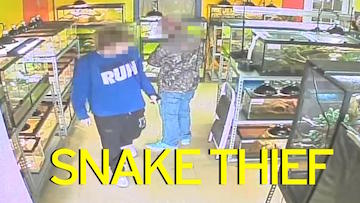 Man Shoves Snake Down His Pants
Man Shoves Snake Down His Pants
Police in South Carolina said a man stole a red-tail boa constrictor from a pet store by shoving the snake down his pants. The Florence Police Department said security camera footage recorded a man, estimated to be between 35 and 40 years old, walked into the unidentified pet store and heading for the area where the snakes are kept. The storeowner told police he heard a noise that he initially thought to be a rat moving inside a cage, but the suspect soon started to act suspiciously and hurried out of the store. The owner then reviewed the security camera footage and saw the man shoving the snake down his pants. "It is very unusual," Florence Police Lt. Mike Brandt told The State. Brandt said it was a "very odd occurrence" for an animal to be stolen from an area pet store. "Only goods, not pets have been reported stolen," Brandt said of previous crimes reported at the stores. The suspect was sought on a larceny charge.
Company Offers "Fur-Ternity" Leave
A Minneapolis marketing company is offering employees "fur-ternity leave," a week of work-from-home days to help new pets adjust. The firm, Nina Hale, announced that it has adopted a company-wide policy of allowing employees to work flexible hours from home for one week when welcoming a new puppy or kitten into their homes. "Part of embracing employee satisfaction as a business priority means recognizing important life events that happen outside of the office," Nina Hale CEO Donna Robinson said. "If we want to continue to set the example as a top workplace, it is crucial to offer innovative benefits that help to preserve the work-life happiness of our employees." The policy was inspired by Connor McCarthy, a senior account manager at the firm, who asked for a week of flexible hours when he recently got a new dog.
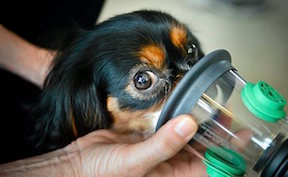 Project Breathe Program Donates Pet Oxygen Masks
Project Breathe Program Donates Pet Oxygen Masks
Have you ever stopped to think about what happens after you get a pet out of a smoke-filled home? It's possible for pets to experience smoke inhalation like humans do. Sometimes, though, giving oxygen to animals isn't so easy. The need to equip fire departments and rescue squads with these oxygen masks continues. One company helping to provide this life-saving equipment is the Invisible Fence Company. It created the Project Breathe Program for the company's pet oxygen mask donation effort. Fire department personnel can request a mask kit for their station house through the Invisible Fence website. Mask kits are reusable; so one kit can go on to save the lives of many pets. Each year, it's estimated that more than 40,000 pets die in fires, most succumbing to smoke inhalation. The reality in most cases is that first responders lack the equipment to resuscitate and save these animals. These donations will give more pets a fighting chance and reduce the number of pet fatalities.
What Days Do People Spend More on Pets?
According to data analysis from Womply, a small business software company, National Dog Day is one of the worst revenue days of the year for the pet services industry (ranking No. 309 of the year), with revenue dropping 20-percent below the daily average. Their data science team analyzed yearly transactions and here's what they found: Average daily revenue in the local pet services industry is $2,129.17 from 18.69 transactions with an average purchase price of $113.89; December is huge for pet stores. The top five sales days of the year are all in December. Three of the top four are the days leading up to Christmas Eve; The top three days for shelters and humane societies are the three days before New Year's Day; People want their pets to look good on big holidays. 3 of the top 5 days for groomers are in the 10 days leading up to Christmas. The other two days are the day before the 4th of July and the day before Thanksgiving; the top four days for local pet boarding businesses come after big holidays specifically New Year's Day, Thanksgiving, and the 4th of July; and the top revenue day for veterinarians is the day after Easter.
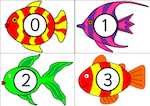 Scientists Show That Fish Can Count
Scientists Show That Fish Can Count
Counting has long been considered the purview of smarter species with higher levels of perceived consciousness, but scientists have shown that fish, often considered near the bottom of the spined-species hierarchy, are able to discern between discrete quantities much like their more cognitively complex counterparts. Moreover, the evidence shows that the way piscine brains "count" is similar to way our own brains process numerical quantities, suggesting deeper evolutionary origins for one of our most essential cognitive skills. The research demonstrated more than just fish's ability to count for their lives. As the food quantities grew larger than four items, the angelfish in the study were less picky with their choice. Other vertebrates behave the same way when presented with large quantities. Vertebrates, including humans, and even some exceptional invertebrates like bees are thought to have separate systems of counting for small and large quantities, in which small numbers are perceived as exact quantities and larger numbers are more roughly estimated. And humans, just like the angelfish in the study, seem to switch from the exact system to the approximate one around the magic number four. Counting aside, studies show that fish's cognitive abilities rival other vertebrates in many ways. Sharks' sense of smell is 10,000 times more sensitive than humans'. Thanks to an extra cone in their eyes, some fish see colors more vividly than we do. Fish can recognize family members, inherit social traditions in the form of migration patterns and use primitive tools. Contrary to beliefs popularized by Finding Nemo, many fish have fantastic memories, avoiding hooks for as long as a year after being caught once and building mental maps of their surroundings that they retain for weeks after being moved.
 Listen to the entire Podcast of this show (#1131)
Listen to the entire Podcast of this show (#1131)





